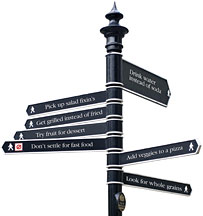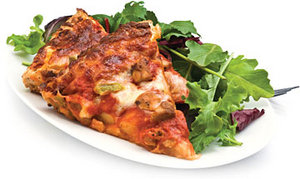Healthy Eating on the Go
Strategies for ensuring balanced nutrition in a fast-food, processed world.
By Sara Tiner
We all know eating right can help us stay healthy and live longer. But it's been a busy day. You're beat. How can you get a healthy dinner on the table fast? You could hit the drive-thru and pick up food for the whole family, or stop by the grocery store for a frozen pizza or a prepackaged dinner. Sure, these might be the fastest options, but are they the healthiest? It may depend on what you choose and how often you choose it. Believe it or not, you can eat a balanced, healthy diet even when you're on the go - if you're willing to make your health a priority. Unhealthy Choices
 We all know unhealthy food generally contains a lot of added fat, sodium (salt), sugar, or chemicals. It's also tasty, cheap, and easy to get. In fact it's everywhere: at eye level in the supermarket, right around the corner, and even delivered piping hot to your door. The processed food industry knows we're busy and need convenient food options, and that these foods can be great in a pinch. Unfortunately, as we get busier, these products show up more frequently in our diet. Because processed food often contains a lot of unhealthy ingredients, we can end up eating in an unhealthy way.
We all know unhealthy food generally contains a lot of added fat, sodium (salt), sugar, or chemicals. It's also tasty, cheap, and easy to get. In fact it's everywhere: at eye level in the supermarket, right around the corner, and even delivered piping hot to your door. The processed food industry knows we're busy and need convenient food options, and that these foods can be great in a pinch. Unfortunately, as we get busier, these products show up more frequently in our diet. Because processed food often contains a lot of unhealthy ingredients, we can end up eating in an unhealthy way. One example of this is fast food. These restaurants specialize in inexpensive food that can be pretty unhealthy if we eat it too often. For example, a standard McDonald's Big Mac value meal (burger, fries, and a soft drink) is a whopping 1,130 calories, all for under $5. With a diet soda, the total dips a bit, but only to 920 calories. Either way, in one meal, we're eating about half our recommended daily calorie intake. Additionally, serving size has increased dramatically over the years. Today's average cheeseburger is roughly 230 calories larger than a cheeseburger made 20 years ago. Because we're also more sedentary than our predecessors, these added calories are a big factor in our growing waistlines. Fast food isn't the only culprit, though. Processed food manufacturers have muddied the waters by making health claims for a single item in their product, such as saying it contains all the calcium or fiber you'll need for the day. However, a product with one enhanced nutrient is often not as healthy as less processed, more balanced alternatives. In fact, the benefit we get from eating these types of processed foods (with that single beneficial ingredient) may be diluted by all the other ingredients that aren't healthy. Making Health a Priority Making healthy food choices is a compromise between our busy lifestyles and our health. We can do it if we make small but meaningful changes in the foods we select. These targeted changes can improve our overall nutrition without a huge cost in time or money. Truly healthy options do exist, and some of them are convenient, but we may need to develop a new set of taste buds (or retrain the old ones) in order to enjoy them. Take white bread for example. It starts off as whole grains but has many of its original (healthy) parts removed to make it white and soft. Then the bread is chemically enriched with just a few vitamins and minerals. Confusing, right? Why not skip the rigmarole and choose whole-wheat bread? It will feed your body with whole nutrition, which is just what your body needs. Other whole foods, like peaches or nuts, will be better fuel for your body than a processed snack. What Can You Do? - Check your supermarket for a salad bar. If you're running in for a frozen pizza, you can put together a salad so you don't fill up on pizza. If the salad bar is too expensive, a cheaper option may be to grab a bag of prewashed spinach for a simple salad.
- If you love ice cream, think of picking up frozen yogurt or sorbet instead. The latter choices generally have less calories and fat, and some may have less sugar, too.
Healthy Substitutions: Eat This, Not That
Next time you hit the drive-thru, think about these healthy substitutions: | Instead Of:
Soft drinks
Double burger patty
Cheeseburger
Salty sides
Fried
Foot long sub
White bread
Sandwich bread
Deep dish with extra cheese
Dressing, gravy, ketchup
Mocha coffee drink | Choose:
Water
Single burger patty
Hamburger
Fruit or vegetable sides
Grilled
Six-inch sub
Whole grain bread
Tortilla (wrap)
Thin crust with extra veggies
Plain, or on the side
Black coffee | - At the drive-thru, stay away from value meals. You can save a lot of calories and improve your health by replacing a high-fat, high-sodium food like French fries with the carrot sticks you have with you, or another side, like apple slices. Also, think about choosing water instead of a soda. It will save you calories and it might save you money.
At home, eating healthy is easier if unhealthy foods aren't available. So instead of chips, think about adding a dash of sea salt to your cucumbers. It's a great way to soothe a salty/crunchy craving instead of breaking out the chips. If you're craving something sweet, try munching on some berries instead of a cookie. Planning Ahead Everyone has a day or week that suddenly fills up, but we often know when we'll be particularly busy at least a little bit beforehand. Plan ahead for when you know making a time-intensive meal won't be an option. You could make an extra batch soup or chili and freeze it. If you have a block of time, think about preparing fruits or vegetables and storing them in handy containers. Then when you're rushing to prepare a snack or dinner, the hard part will already be done. Also consider investing in a rice cooker, a vegetable steamer or a slow cooker. These kitchen tools can take over while you're busy doing something else. Another way to fill the nutritional gaps in your daily diet is to take supplements. Whole-food multivitamins or nutrient replacements, like fish oil or calcium, can help you reach your health goals. Some supplements are specifically designed for adults, children, men or women. Different people need different types of support, so check with your health care professional to see what will work best for you and your family. Finally, one very important change you can make is to pack your child's lunch. Teaching healthy eating patterns sets children on a lifetime path of nutritional health. Prepared food producers know this; it's why they often target young children - to get them hooked for a lifetime. Also, while school lunch programs are incredibly important in meeting the needs of many children, they may not offer good meal choices. Making your child's lunch (and your own, while you're at it) does require more time and planning, but as it becomes a habit the benefit will outweigh your time spent. Aim for a balanced lunch of whole grains, fruit, vegetables, low-fat dairy and lean protein. Your child may not go for all those options at first, but every little bit helps, and you'll be planting seeds for their future good health. Every Little Bit Helps
 Eating healthy is not always easy. Healthy options can be hard to find, hard to finance and hard to introduce into your family's diet. Trying to make healthy changes can seem overwhelming. The key point to remember is that every little bit helps. If you can't eliminate convenience food, make healthier choices in where and what type of food you eat (for example, baked vs. fried). Making gradual changes will give you time to develop new tastes and help you better understand what choices work best for your family. When you invest time now, you'll soon start to notice huge rewards.
Eating healthy is not always easy. Healthy options can be hard to find, hard to finance and hard to introduce into your family's diet. Trying to make healthy changes can seem overwhelming. The key point to remember is that every little bit helps. If you can't eliminate convenience food, make healthier choices in where and what type of food you eat (for example, baked vs. fried). Making gradual changes will give you time to develop new tastes and help you better understand what choices work best for your family. When you invest time now, you'll soon start to notice huge rewards.
Shopping Solutions
At the supermarket, remember to: - Stop by the salad bar to throw together a quick salad.
- Buy some pre-cut fruit or vegetables for lunch and snack time.
- Pick up frozen fruit to have on hand for cereal or smoothies.
- Skip the chips and buy a variety of nuts to crunch on.
- Put the ice cream back and choose frozen yogurt, sorbet, or a fruit smoothie as a treat.
- Avoid trans fats or partially hydrogenated oils (found in things like restaurant foods, snack foods, vegetableshortening, and most crackers).
- Avoid high-fructose corn syrup (found in some sodas, juice drinks, condiments, and many other processed foods).
Sara Tiner, BA, BS, MS, is the coordinator of scientific communication for a whole-food supplement manufacturer in Wisconsin. With undergraduate degrees in biology and English from Ripon College, and a master's degree in journalism from Columbia University, she's worked as a science writer in both print and radio over the past decade, and moonlights as a freelance contributor to various publications.
Page printed from:
http://www.toyourhealth.com/mpacms/tyh/article.php?id=1215&no_paginate=true&no_b=true
|

